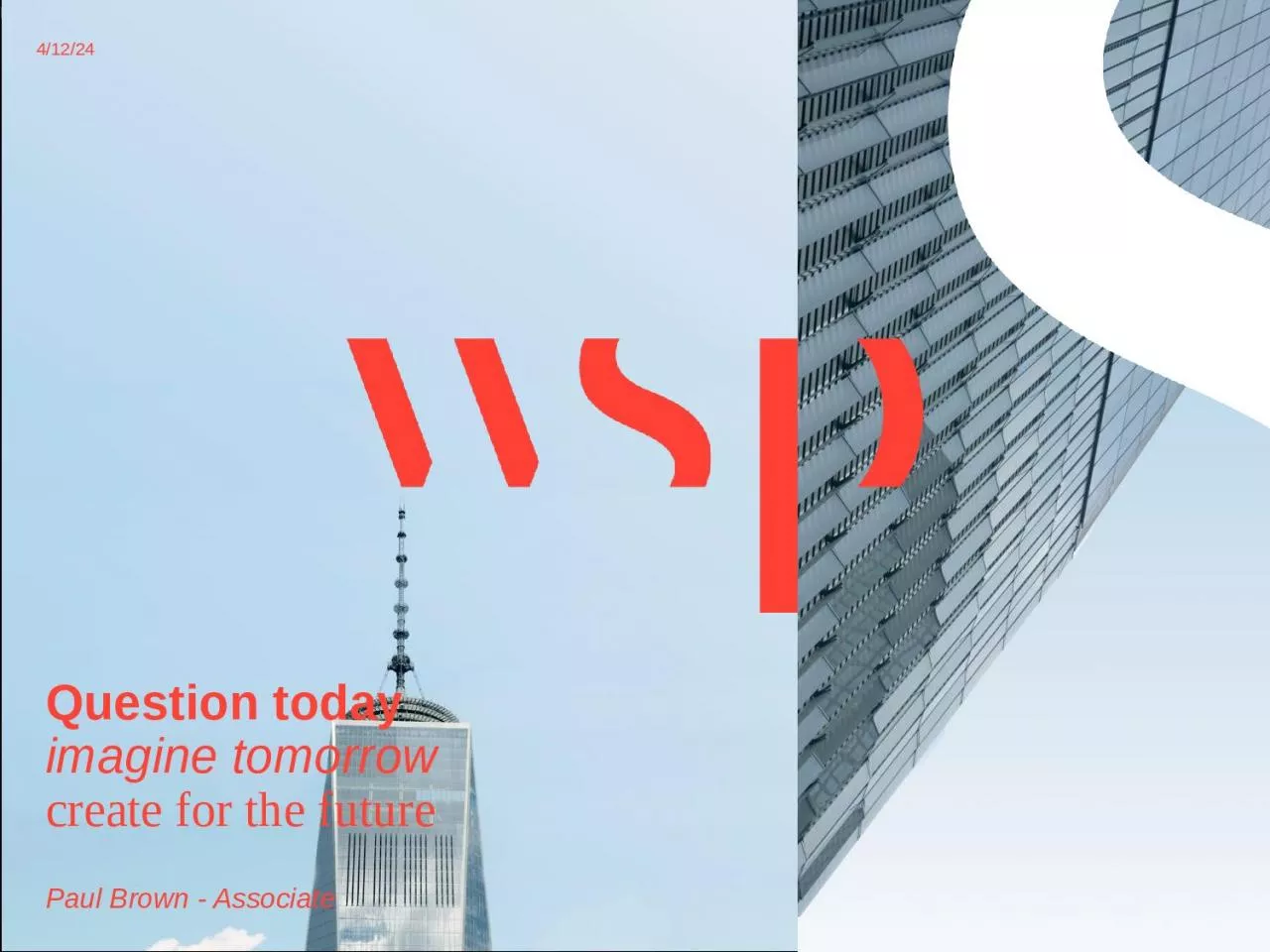

create for the future Paul Brown Associate July 24 2019 GG182 Major Schemes Enabling handover into operation and maintenance Selected Highlights Simplified requirements Most changes associated with rules for new DMRB ID: 933459
Download Presentation The PPT/PDF document "Question today imagine tomorrow" is the property of its rightful owner. Permission is granted to download and print the materials on this web site for personal, non-commercial use only, and to display it on your personal computer provided you do not modify the materials and that you retain all copyright notices contained in the materials. By downloading content from our website, you accept the terms of this agreement.
Slide1
Question today
imagine tomorrow
create for the future
Paul Brown - Associate
July 24, 2019
Slide2GG182 – Major Schemes: Enabling handover into operation and maintenance
Selected Highlights
Simplified requirements
Most changes associated with rules for new DMRB
RACI matrices removed – but have to be preparedIncreased BIM requirementsReduced requirements relating to H&S fileSame stages as appeared in IAN182Schemes shall be designed in accordance with requirements of GD304
Slide3GD 304 – Designing health and safety into maintenance
Overview
Three (and a bit) main elements
Design Risk Management
Stakeholder engagementMaintenance and repair statementExamples of methods used to reduce risks in design
Slide4GD 304 - Key items 1
Design risk management
Must apply the principles of prevention
Should have a structured and recorded process of design reviews to consider whole life health and safety risks
Assessment of risk should consider capital and whole life operational and maintenance costsFor health and safety measure not to be implemented, whole life costs should be grossly disproportionate to the benefit
Slide5GD 304 - Key items 2
Maintenance and Repair Statement
To be prepared during design phase
Updated as necessary throughout life of the asset
Principal designer to advise overseeing organisation of implications of the approach to maintenanceGeneral section on the scheme and maintenance requirementsSeries of maintenance philosophy statements covering individual assets or groups of assets – requirement broadly as per existing Maintenance and Repair strategy statementsRecords of design meetings and stakeholder engagement which consider design for maintenance
Slide6GD 304 - Key items 3
Examples of methods used to reduce risks in design
Table of methods of managing risks and examples of their use
Not updated from IAN69/15
Table split into 3 groups coveringeliminating hazards reducing hazardsinforming others of the hazardswith 9 sub-sections.
Slide7GG182 / GD 304 – Questions / Discussion
Slide8Raising the Bar Template 1
Objective:
Describe the overall aim and objective of the raising the bar document. What we are trying to achieve
Scope:
Explain who is in scope i.e. who is the target audience, MP, OD, All Suppliers, everyone including traffic officers
Background:
Where relevant provide some background on why this topic was chosen as a raising the bar. Raising the Bars are generally developed to provide a consistent standard, due to poor inspection scores or following a trend in incidents.
Minimum Standard:
The following elements are mandatory requirements and suppliers shall ensure these elements are applied fully on Highways England sites. Failure to comply will result in a Red finding during Highways England Assurance visits
.
.
Slide9Raising the Bar Template 2
Guidance:
This Guidance is written with the expectation that it represents best practice and as such if you are involved in this type of activity will normally be followed unless a better local solution has been devised to meet the overall objective.
The guidance provided should be structured around the Plan, Organise, Control and Monitor headings with a strong focus on eliminating hazards where possible through the Planning (Design) stage.
Plan
Design process
Risk assessment and planning
Detailed planning of work tasks
People requirements
Equipment requirements
Organise
Workplace Hazards
Vehicle, plant and equipment use
Control
Risks / controls
Permits
Responsibilities of Personnel
Monitor
Audit / Inspection arrangements
Emergency arrangements
Incident Investigation
Specific Examples
The following are examples of good practice where projects have met the minimum expectations of Highways England
.
Slide10Raising the Bar 26 - Whole life design for Health, Safety and Wellbeing
Current Contents – Draft October 2018
Objective
Scope
BackgroundPlanning for safe and healthy designsProject managementBuilding Information ManagementHuman Factors
Designing for safety and healthDesign Risk ManagementChecking effectiveness of safety and health in designReviewing safe and healthy designsAppendix A – Designers ChecklistQuestions to challenge designers on how they approach implementing health and safety in their designs and design processesAppendix B – Minimum requirements and desirable standardsGuidance on expectations and accepted good practice without actual examples
Slide11Raising the Bar 26 - Whole life design for Health, Safety and Wellbeing
Questions / Issues
Are the RtB template /headings appropriate for a design focused RtB?
What do we want RtB 26 to do?
How do we make it different from GD304?
Are there any mandatory minimum requirements which go beyond GD304?GD304 has a table of good practice supported by examples, does RtB26 need appendix B? Would a statement requiring adoption of methods identified in Table E of GD304 suffice?Is inclusion of Wellbeing in the title beneficial?Should BIM and PAS 1192-6 be specifically covered?